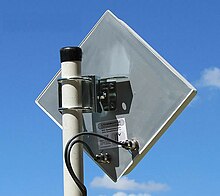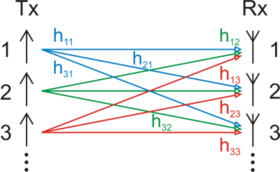MIMO
More recently, MIMO has been applied to power-line communication for three-wire installations as part of the ITU G.hn standard and of the HomePlug AV2 specification.MIMO is often traced back to 1970s research papers concerning multi-channel digital transmission systems and interference (crosstalk) between wire pairs in a cable bundle: AR Kaye and DA George (1970),[5] Branderburg and Wyner (1974),[6] and W. van Etten (1975, 1976).[7] Although these are not examples of exploiting multipath propagation to send multiple information streams, some of the mathematical techniques for dealing with mutual interference proved useful to MIMO development.[8] Methods were developed to improve the performance of cellular radio networks and enable more aggressive frequency reuse in the early 1990s.Space-division multiple access (SDMA) uses directional or smart antennas to communicate on the same frequency with users in different locations within range of the same base station.5515378 issued in 1996[9]) describes a method for increasing capacity using "an array of receiving antennas at the base station" with a "plurality of remote users."Paulraj was awarded the prestigious Marconi Prize in 2014 for "his pioneering contributions to developing the theory and applications of MIMO antennas."[11] In an April 1996 paper and subsequent patent, Greg Raleigh proposed that natural multipath propagation can be exploited to transmit multiple, independent information streams using co-located antennas and multi-dimensional signal processing.Later that year (September 1996) Gerard J. Foschini submitted a paper that also suggested it is possible to multiply the capacity of a wireless link using what the author described as "layered space-time architecture."[13] Greg Raleigh, V. K. Jones, and Michael Pollack founded Clarity Wireless in 1996, and built and field-tested a prototype MIMO system.Greg Raleigh and V. K. Jones founded Airgo Networks in 2001 to develop MIMO-OFDM chipsets for wireless LANs.The Institute of Electrical and Electronics Engineers (IEEE) created a task group in late 2003 to develop a wireless LAN standard delivering at least 100 Mbit/s of user data throughput.[23] Surendra Babu Mandava and Arogyaswami Paulraj founded Beceem Communications in 2004 to produce MIMO-OFDM chipsets for WiMAX.[25] A nationwide WiMAX network was built in the United States by Clearwire, a subsidiary of Sprint-Nextel, covering 130 million points of presence (PoPs) by mid-2012.[26] Sprint subsequently announced plans to deploy LTE (the cellular 4G standard) covering 31 cities by mid-2013[27] and to shut down its WiMAX network by the end of 2015.[29] Long term evolution (LTE) is based on MIMO-OFDM and continues to be developed by the 3rd Generation Partnership Project (3GPP).[33] MIMO can be sub-divided into three main categories: precoding, spatial multiplexing (SM), and diversity coding.Spatial multiplexing is a very powerful technique for increasing channel capacity at higher signal-to-noise ratios (SNR).In wireless local area networks (WLAN), the IEEE 802.11n (Wi-Fi), MIMO technology is implemented in the standard using three different techniques: antenna selection, space-time coding and possibly beamforming.[49] Spatial multiplexing techniques make the receivers very complex, and therefore they are typically combined with orthogonal frequency-division multiplexing (OFDM) or with orthogonal frequency-division multiple access (OFDMA) modulation, where the problems created by a multi-path channel are handled efficiently.In 3GPP, High-Speed Packet Access plus (HSPA+) and Long Term Evolution (LTE) standards take MIMO into account.This can be posed as a statistical detection problem, and addressed using a variety of techniques including zero-forcing,[53] successive interference cancellation a.k.a.In practice, in communication systems, the transmitter sends a Pilot signal and the receiver learns the state of the channel (i.e.,Signals with a high PAR (peak-to-average ratio) can cause amplifiers to compress unpredictably during transmission.Conversely, the transmitter's performance under a number of different conditions can be verified using a channel emulator and a calibrated receiver, such as a vector signal analyzer (VSA).The transmitter can then apply the correct phase and amplitude adjustments to form a beam directed at the mobile device.This is known as the multiplexing gain and this basic finding in information theory is what led to a spurt of research in this area.[63][64][65] There exists a fundamental tradeoff between transmit diversity and spatial multiplexing gains in a MIMO system (Zheng and Tse, 2003).[66] In particular, achieving high spatial multiplexing gains is of profound importance in modern wireless systems.In Shang, Sun and Zhou (2007), sufficient and necessary conditions are established to guarantee the complete recovery of the multi-input signals.


MIMO (disambiguation)AntennasCommon typesDipoleFractalMonopoleSatellite dishTelevisionBlock upconverterCoaxial cableCounterpoise (ground system)Feed lineLow-noise block downconverterPassive radiatorReceiverRotatorTransmitterTwin-leadAntenna farmAmateur radioCellular networkHotspotMunicipal wireless networkRadio masts and towersWirelessWireless device radiation and healthWireless electronic devices and healthInternational Telecommunication UnionRadio RegulationsWorld Radiocommunication ConferenceBoresightFocal cloudGround planeMain lobeNear and far fieldSide lobeVertical planeArray gainDirectivityEfficiencyElectrical lengthEquivalent radiusFactorFriis transmission equationHeightRadiation patternRadiation resistanceRadio propagationRadio spectrumSignal-to-noise ratioSpurious emissionBeam steeringBeam tiltBeamformingSmall cellBell Laboratories LayeredSpace-Time (BLAST)ReconfigurationSpread spectrumWideband Space DivisionMultiple Access (WSDMA)multipath propagationIEEE 802.11nIEEE 802.11acLong Term Evolutionpower-line communicationHomePlugBell LaboratoriesSpace-division multiple accessBjörn OtterstenArrayCommArogyaswami PaulrajThomas KailathMarconi PrizeGreg RaleighMIMO-OFDMGerard J. FoschiniMIMO technology in WiMAXMIMO technology in 3G mobile standardswireless LANsAirgo NetworksInstitute of Electrical and Electronics EngineersPhilipsBroadcomTexas InstrumentsMotorolaMitsubishi802.16eClearwireSprint-Nextelpoints of presenceNTT DoCoMo3rd Generation Partnership ProjectLTE AdvancedTeliaSoneraprecodingspatial multiplexingdiversity codingline-of-sight propagationchannel state informationmulti-user MIMOchannel knowledgespace-time codingantenna diversitySingle-input single-outputBell Laboratories Layered Space-TimewavelengthsCooperative MIMOMacrodiversityroutingorthogonal frequency-division multiplexingorthogonal frequency-division multiple accessmobile radio telephoneHigh-Speed Packet Access plus (HSPA+)Long Term Evolution (LTE)MIMO radarG.9963matrixvectorsnarrowbandflat fadinginformation theorychannel capacityHermitian transposesingular value decompositionwaterfillingmutual informationspatial correlation

